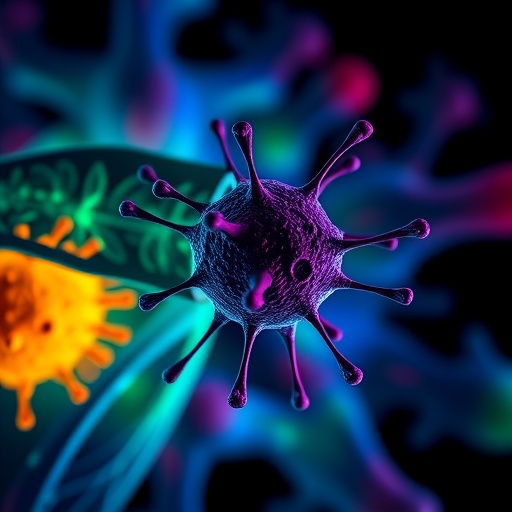
In a groundbreaking advance that could redefine how clinicians diagnose and predict outcomes in Acute Myeloid Leukemia (AML), a team of scientists has leveraged the power of epigenomics to unravel intricate molecular signatures underlying this aggressive blood cancer. The recent study, spearheaded by Marchi, Shastri, Marrero, and colleagues, dives deep into the epigenomic landscapes of AML cells, elucidating how distinct DNA methylation patterns and chromatin modifications serve not only as markers for diagnosis but also as robust predictors of patient prognosis. This research promises to propel personalized medicine in hematologic malignancies to new heights by integrating epigenomic profiling into routine clinical workflows.
AML remains one of the deadliest leukemias, characterized by rapid proliferation of aberrant myeloid progenitor cells that disrupt normal hematopoiesis. Despite decades of research, the heterogeneity of AML at the genetic and epigenetic level has posed a formidable barrier to precise classification and risk stratification. Traditionally, cytogenetic abnormalities and gene mutations have been the mainstay for AML diagnosis, yet these do not fully capture the disease’s complexity or adequately predict therapeutic responses. This study pioneers a complementary dimension—epigenomic markers—that meticulously reflect the cell-of-origin and dynamic regulatory states of leukemia cells, thereby refining the diagnostic criteria and enriching prognostic accuracy beyond conventional approaches.
The researchers harnessed state-of-the-art technologies to interrogate the epigenetic modifications that regulate gene expression without altering the underlying DNA sequence. Chief among these modifications is DNA methylation, a process where methyl groups attach to cytosine residues, typically at CpG dinucleotides, influencing gene silencing or activation. By comprehensively profiling genome-wide DNA methylation patterns across a sizable cohort of AML samples, the team identified unique epigenetic fingerprints that distinguish AML subtypes with remarkable specificity. These methylation signatures not only mirrored known genetic mutations but also uncovered previously unrecognized epigenetic aberrations critical to leukemogenesis.
.adsslot_FbNqgIcJl4{width:728px !important;height:90px !important;}
@media(max-width:1199px){ .adsslot_FbNqgIcJl4{width:468px !important;height:60px !important;}
}
@media(max-width:767px){ .adsslot_FbNqgIcJl4{width:320px !important;height:50px !important;}
}
ADVERTISEMENT
Beyond methylation, the study explored chromatin accessibility and histone modifications, further elucidating the epigenomic architecture shaping AML phenotypes. Chromatin dynamics govern the accessibility of transcriptional machinery to DNA and thus influence the expression of oncogenes or tumor suppressors. Using cutting-edge assays such as ATAC-seq and ChIP-seq, the investigators mapped regions of open chromatin and key histone marks, unearthing regulatory elements that differ between prognostic risk groups. This multi-layered epigenomic analysis provides a comprehensive blueprint of the molecular circuitry driving AML progression and resistance to therapy.
One of the most striking outcomes of this work is the development of an epigenomic-based diagnostic classifier capable of accurately categorizing AML patients at diagnosis. This classifier integrates methylation profiles with chromatin state indicators to assign patients into biologically meaningful groups that correlate strongly with clinical outcomes. Compared to traditional stratification methods, the epigenomic classifier demonstrated superior predictive power for overall survival and relapse risk, offering clinicians a potent new tool to tailor treatment strategies. Moreover, it holds promise for early detection of minimal residual disease, potentially enabling preemptive interventions to curb relapse.
The implications of these findings extend into the realm of prognosis, where existing models often fall short given AML’s clinical and molecular diversity. By capturing the epigenetic heterogeneity within leukemic blasts, the study introduces a refined prognostic framework that discriminates high-risk patients from those likely to respond favorably to standard therapies. This could revolutionize patient management, guiding decisions on the intensity of chemotherapy, transplantation candidacy, or enrollment in clinical trials for novel agents. Furthermore, the epigenomic signatures may serve as biomarkers to monitor treatment responses dynamically, thus enhancing personalized medicine precision.
Underpinning this scientific breakthrough is a meticulous batch processing of high-throughput datasets followed by advanced computational modeling. Employing machine learning algorithms, the research team distilled complex epigenomic data into interpretable classifiers that bridge molecular biology with clinical utility. The robustness of these models was validated across independent AML cohorts, showcasing generalizability and potential for adoption in diverse healthcare settings. The fusion of wet-lab epigenomics with computational science stands as a testament to the power of interdisciplinary research in oncology.
Importantly, this study sheds light on the biological mechanisms by which epigenomic dysregulation fuels AML pathogenesis. The alterations in methylation and chromatin architecture disrupt normal gene regulatory networks, leading to aberrant cell proliferation, impaired differentiation, and evasion of apoptosis. By pinpointing these epigenetic drivers, the research opens avenues for targeted therapeutics aimed at reversing maladaptive epigenetic states. Epigenetic drugs such as DNA methyltransferase inhibitors and histone deacetylase inhibitors could be strategically deployed or refined based on patient-specific epigenomic profiles, paving the way for combination therapies grounded in molecular precision.
The translational potential of deploying epigenomic diagnostics in clinical laboratories warrants emphasis. Advances in sequencing technologies have made methylation and chromatin assays more accessible and cost-effective than ever before. Integrating these assays alongside traditional genetic tests could form a comprehensive diagnostic arsenal, enhancing early detection and allowing intervention before overt clinical decline. This integration may also address challenges related to AML heterogeneity that conventional genetic analyses sometimes overlook, particularly in cases lacking clear driver mutations.
Beyond immediate clinical implications, the study enriches fundamental understanding of hematopoietic cell biology and leukemogenesis. Epigenomic landscapes delineated in AML reflect disruptions in normal hematopoietic hierarchies, potentially revealing the cellular origins of distinct AML subtypes. This knowledge deepens insights into how normal differentiation trajectories are hijacked during malignant transformation, informing future research on stem cell plasticity and leukemia stem cell niches. Such foundational insights could inspire novel preventative strategies or early therapeutic targeting to disrupt disease initiation.
The authors also acknowledge limitations and future directions, emphasizing the need for larger, longitudinal cohorts to capture temporal epigenomic changes during disease evolution and treatment. Such studies could elucidate mechanisms of acquired resistance and clonal evolution, informing adaptive therapeutic regimens. Moreover, integrating epigenomic data with transcriptomic, proteomic, and metabolomic profiles may yield even more powerful predictive models and unveil comprehensive molecular networks in AML.
Another promising dimension involves exploring epigenomic biomarkers in peripheral blood samples, facilitating minimally invasive diagnostics and monitoring. The feasibility of detecting leukemia-associated methylation signatures in circulating tumor DNA would expand clinical utility, enabling real-time tracking of disease burden and response to therapy. This approach aligns with the ongoing trend toward liquid biopsies revolutionizing cancer management with improved patient compliance and rapid turnaround times.
Overall, this landmark study marks a paradigm shift in AML diagnosis and prognosis by illuminating the epigenomic undercurrents steering disease behavior. The fusion of cutting-edge epigenetic profiling technologies with sophisticated computational analytics yields a powerful platform with tangible clinical impact. As the field embraces these insights, personalized management of AML may transform from a challenging endeavor into a precision-guided science, offering new hope for improved survival and quality of life for patients facing this formidable malignancy.
The study’s implications reverberate beyond AML, suggesting that epigenomic diagnostics could be adapted across hematologic and solid tumors where genetic analyses alone do not fully capture disease complexity. As precision oncology evolves, incorporating multi-omic layers such as epigenetics will be fundamental to unlocking personalized care tailored to the unique molecular architectures of each patient’s cancer. This research thus stands at the vanguard of a new era in cancer diagnostics and therapeutics.
In conclusion, the meticulous work by Marchi, Shastri, Marrero, and collaborators advances the frontier of leukemia research by harnessing the epigenome as a diagnostic and prognostic beacon. Their integrative, multi-modal approach provides a scalable blueprint for precision oncology that holds immense promise for reshaping AML patient management. By transforming epigenomic insights into actionable clinical tools, this study exemplifies how modern genomic medicine can translate molecular discovery into tangible benefits for cancer patients worldwide.
Subject of Research: Epigenomic profiling for diagnosis and prognosis in Acute Myeloid Leukemia (AML)
Article Title: Epigenomic diagnosis and prognosis of Acute Myeloid Leukemia
Article References:
Marchi, F., Shastri, V.M., Marrero, R.J. et al. Epigenomic diagnosis and prognosis of Acute Myeloid Leukemia. Nat Commun 16, 6961 (2025). https://doi.org/10.1038/s41467-025-62005-4
Image Credits: AI Generated
Tags: chromatin modifications and cancer prognosisdiagnosis and prediction in AMLDNA methylation patterns in AMLepigenomic profiling in clinical workflowsepigenomics in acute myeloid leukemiaheterogeneity of acute myeloid leukemiainnovative research in blood cancerMarchi Shastri Marrero AML studymolecular signatures of blood cancerpersonalized medicine in hematologic malignanciesrisk stratification in leukemiatherapeutic responses in AML treatment





